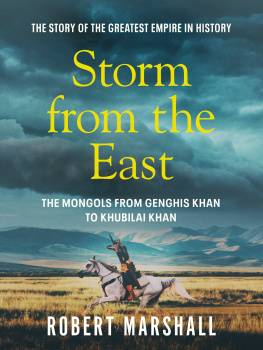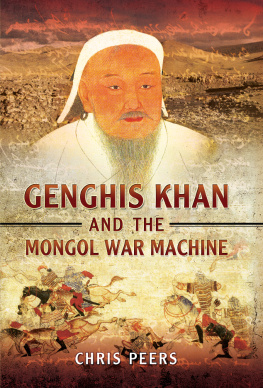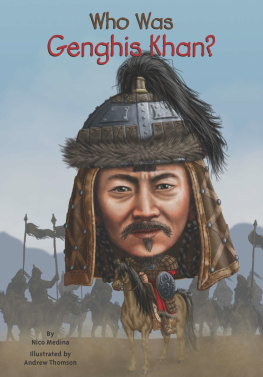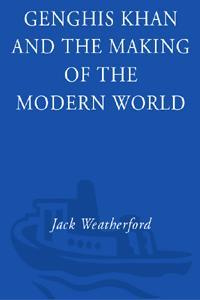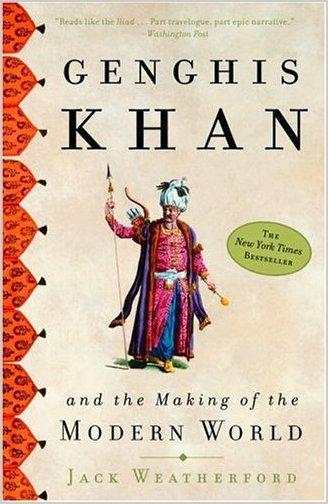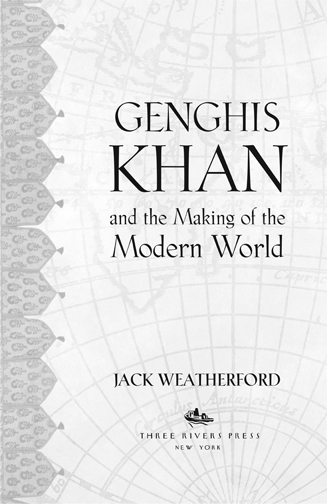
This noble king was called Genghis Khan,
Who in his time was of so great renown
That there was nowhere in no region
So excellent a lord in all things.
GEOFFREY CHAUCER,
The Squires Tale,
The Canterbury Tales (c. 1395)
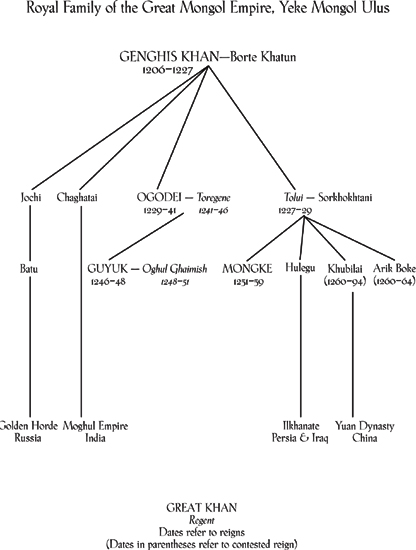
Introduction
The Missing Conqueror

Genghis Khan was a doer.
WASHINGTON POST, 1989
I N 1937, THE SOUL of Genghis Khan disappeared from the Buddhist monastery in central Mongolia along the River of the Moon below the black Shankh Mountains where the faithful lamas had protected and venerated it for centuries. During the 1930s, Stalins henchmen executed some thirty thousand Mongols in a series of campaigns against their culture and religion. The troops ravaged one monastery after another, shot the monks, assaulted the nuns, broke the religious objects, looted the libraries, burned the scriptures, and demolished the temples. Reportedly, someone secretly rescued the embodiment of Genghis Khans soul from the Shankh Monastery and whisked it away for safekeeping to the capital in Ulaanbaatar, where it ultimately disappeared.
Through the centuries on the rolling, grassy steppes of inner Asia, a warrior-herder carried a Spirit Banner, called a sulde, constructed by tying strands of hair from his best stallions to the shaft of a spear, just below its blade. Whenever he erected his camp, the warrior planted the Spirit Banner outside the entrance to proclaim his identity and to stand as his perpetual guardian. The Spirit Banner always remained in the open air beneath the Eternal Blue Sky that the Mongols worshiped. As the strands of hair blew and tossed in the nearly constant breeze of the steppe, they captured the power of the wind, the sky, and the sun, and the banner channeled this power from nature to the warrior. The wind in the horsehair inspired the warriors dreams and encouraged him to pursue his own destiny. The streaming and twisting of the horsehair in the wind beckoned the owner ever onward, luring him away from this spot to seek another, to find better pasture, to explore new opportunities and adventures, to create his own fate in his life in this world. The union between the man and his Spirit Banner grew so intertwined that when he died, the warriors spirit was said to reside forever in those tufts of horsehair. While the warrior lived, the horsehair banner carried his destiny; in death, it became his soul. The physical body was quickly abandoned to nature, but the soul lived on forever in those tufts of horsehair to inspire future generations.
Genghis Khan had one banner made from white horses to use in peacetime and one made from black horses for guidance in war. The white one disappeared early in history, but the black one survived as the repository of his soul. In the centuries after his death, the Mongol people continued to honor the banner where his soul resided. In the sixteenth century, one of his descendants, the lama Zanabazar, built the monastery with a special mission to fly and protect his banner. Through storms and blizzards, invasions and civil wars, more than a thousand monks of the Yellow Hat sect of Tibetan Buddhism guarded the great banner, but they proved no match for the totalitarian politics of the twentieth century. The monks were killed, and the Spirit Banner disappeared.
Fate did not hand Genghis Khan his destiny; he made it for himself. It seemed highly unlikely that he would ever have enough horses to create a Spirit Banner, much less that he might follow it across the world. The boy who became Genghis Khan grew up in a world of excessive tribal violence, including murder, kidnapping, and enslavement. As the son in an outcast family left to die on the steppes, he probably encountered no more than a few hundred people in his entire childhood, and he received no formal education. From this harsh setting, he learned, in dreadful detail, the full range of human emotion: desire, ambition, and cruelty. While still a child he killed his older half brother, was captured and enslaved by a rival clan, and managed to escape from his captors.
Under such horrific conditions, the boy showed an instinct for survival and self-preservation, but he showed little promise of the achievements he would one day make. As a child, he feared dogs and he cried easily. His younger brother was stronger than he was and a better archer and wrestler; his half brother bossed him around and picked on him. Yet from these degraded circumstances of hunger, humiliation, kidnapping, and slavery, he began the long climb to power. Before reaching puberty, he had already formed the two most important relationships of his life. He swore eternal friendship and allegiance to a slightly older boy who became the closest friend of his youth but turned into the most dedicated enemy of his adulthood, and he found the girl whom he would love forever and whom he made the mother of emperors. The dual capacity for friendship and enmity forged in Genghis Khans youth endured throughout his life and became the defining trait of his character. The tormenting questions of love and paternity that arose beneath a shared blanket or in the flickering firelight of the family hearth became projected onto the larger stage of world history. His personal goals, desires, and fears engulfed the world.
Year by year, he gradually defeated everyone more powerful than he was, until he had conquered every tribe on the Mongolian steppe. At the age of fifty, when most great conquerors had already put their fighting days behind them, Genghis Khans Spirit Banner beckoned him out of his remote homeland to confront the armies of the civilized people who had harassed and enslaved the nomadic tribes for centuries. In the remaining years of life, he followed that Spirit Banner to repeated victory across the Gobi and the Yellow River into the kingdoms of China, through the central Asian lands of the Turks and the Persians, and across the mountains of Afghanistan to the Indus River.
In conquest after conquest, the Mongol army transformed warfare into an intercontinental affair fought on multiple fronts stretching across thousands of miles. Genghis Khans innovative fighting techniques made the heavily armored knights of medieval Europe obsolete, replacing them with disciplined cavalry moving in coordinated units. Rather than relying on defensive fortifications, he made brilliant use of speed and surprise on the battlefield, as well as perfecting siege warfare to such a degree that he ended the era of walled cities. Genghis Khan taught his people not only to fight across incredible distances but to sustain their campaign over years, decades, and, eventually, more than three generations of constant fighting.


